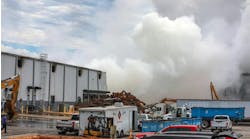In August, the U.S. Occupational Safety and Health Administration (OSHA) announced it is considering revisiting the Process Safety Management (PSM) standard. This column summarizes why OSHA is thinking of amending the standard and what you can do to engage in the process.
PSM Standard
OSHA issued the PSM standard in 1992. As most readers know, the standard requires employers to implement a variety of programs that identify, evaluate and seek to control highly hazardous chemicals. Importantly, the PSM standard is “performance-based.” This means the standard outlines the elements needed to control highly hazardous chemicals but lets the employer decide how best to design and implement its specific PSM programs. Such an approach ensures maximum employer flexibility. The standard identifies 14 management system elements that must be addressed in designing a PSM standard program sufficient to satisfy the rule.
The PSM standard has not been revised since its implementation. Much has happened in the intervening 30 years. OSHA noted one such key event is the 2013 ammonium nitrate explosion in Waco, Texas. This disastrous event apparently “renewed” OSHA’s interest in revisiting the PSM standard at the time. That intent was augmented by President Obama’s 2013 Executive Order (EO) 13650, Improving Chemical Facility Safety and Security, which was issued in large part in response to the Waco incident. EO 13650 directed OSHA, the U.S. Environmental Protection Agency (EPA) and other federal agencies to modernize policies, regulations, and standards to enhance safety and security in chemical facilities by completing prescribed tasks. Among those tasks is the review of the PSM standard and the EPA’s Risk Management Plan (RMP) rules to determine if covered hazardous chemicals lists should be expanded.
OSHA requested public comment previously on significant changes to the PSM standard. For example, in 2013, OSHA considered potential updates to its Explosives and Blasting Agents, Flammable Liquids, and Spray Finishing PSM standards. OSHA specifically requested comment on updating the list of highly hazardous chemicals in Appendix A of the PSM standard. However, the list has remained unchanged. OSHA also requested comment on whether any chemicals should be added to Appendix A and on methods for updating Appendix A with new chemicals in the future as “new hazards are discovered and as technology and advancements in chemical science evolve.” The need to consider updating this list, of course, resonates today as much as it did in 2013.
For its part, the EPA initiated a separate rulemaking and proposed amendments to the RMP in 2017 and 2019.
In its newest initiative, OSHA has solicited stakeholder comment on a long list of topics it enumerates in the September 20, 2022, Federal Register notice. While all are important, particular note is made here of OSHA’s interest in clarifying “paragraph (e) to require consideration of natural disasters and extreme temperatures in the PSM programs ….” Other significant issues include: clarifying paragraph (l) on organizational changes; revising paragraph (n) to require coordination of emergency planning with local emergency response authorities; amending paragraph (m) to require root cause analysis; expanding paragraph (c) to strengthen employee participation and include stop work authority; and amending paragraph (o) to require third-party compliance audits, among many other very important topics.
OSHA held a public stakeholder meeting virtually on Webex on October 12, 2022. It generated significant interest given the broad implications of the initiative. Interested stakeholders are invited to submit comment by November 14, 2022. All comments will be available for review online.
Discussion
This is a major initiative, and long overdue. Most would agree the PSM standard is essential to ensuring the safety of chemical facilities and much has changed since 1992. OSHA’s consideration of paragraph (e) is especially timely in the wake of Hurricane Ian. Natural disasters like hurricanes are occurring at a pace and with an intensity that makes reconsideration of this component of the PSM standard urgent.
Not everyone will be pleased. Certain areas on which comment is requested are likely to invite pushback. Any requirement that mandates third-party audits, for example, is expected to be opposed.
Stakeholders are urged to engage. OSHA will need help, and the PSM standard is too important to not get it right.



